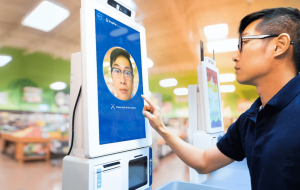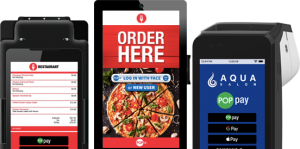Shopping for necessities during a pandemic can be a challenge and a risk for shoppers and staffers alike.
The need to observe social distancing and physical separation has been identified as a way to combat the spread of the coronavirus, but it is a difficult ask in the drug store, the supermarket or the corner convenience store.
Contact-reduced shopping and cashless payment methods that keep customers and checkout clerks as separated as possible are being more widely implemented. Using a charge card may be safer than exchanging cash, but some customers wonder why they should even have to open their wallet or purse, handle a card or touch those buttons on the credit card reader.
So could so-called smart surveillance tools like biometrics and facial recognition help make shopping safer? The coronavirus crisis has led to increased discussion if not application of facial recognition technologies by companies, organizations and governments worldwide. They see facial recognition as a useful tool to maintain safety and security in retail, healthcare, education, financial services, public transit, and other shared spaces.
Surveillance technologies can also be used in the diagnosis of the disease by using sensors to capture and analyze patient status, including temperature, and incorporating data with cameras and software systems that can be used to determine age, sex, and other biometric identifying factors.
Would you like fries with that diagnosis?
One California-based burger chain will be removing all its cash and credit card payment systems, replacing them with a facial biometric payment service called PopPay.
CaliBurger customers first register at popid.com; they can then order and pay online or using new POS terminals in the restaurants. The new payment system, along with a fever detection system for store entry, facial recognition access control for employees and AI-powered robot cooks, will be installed at all CaliBurger locations.
The coronavirus crisis surely has triggered the implementation of this system, but it is also seen as a business development tool: because collected data can include shopper habits and preferences, the collected information can be used to personalize future recommendations and interaction.
Customer Convenience, Shopping Experience Enhancements Made in China?
The ability to give “consumers a new level of convenience for payments at retail outlets: has been an existing pitch to shoppers for the implementation of facial recognition platforms. For merchants, they are seen as a way

Facial recognition technology is an increasingly popular method of payment among global consumers,” says Spencer Xu, CEO and founder of SnapPay, a facial recognition technology company based near Toronto. Provided image.
to boost the retail value proposition through a greater understanding of the customer’s shopping process and preferences (if not increasing the number of in-store self-checkout lanes), among other benefits.
“Facial recognition technology is an increasingly popular method of payment among global consumers,” says Spencer Xu, CEO and founder of SnapPay, a facial recognition technology company based near Toronto. “By enabling consumers to pay with their ‘face’ North American merchants, particularly those with self-service kiosks, are providing an unprecedented level of convenience and speed in the checkout process, to a lucrative customer segment that increasingly demands it.”
SnapPay announced the availability of facial recognition payment technology for North American merchants, based on available facial recognition platforms available in Asia. The company also has agreements with leading Canadian retailers to roll-out its payment gateway that allows merchants to accept digital payments from popular Chinese payment systems such as AliPay and WeChat Pay.
S -With a simple QR scan of its mobile app, the SnapPay platform enables consumers to pay in Chinese currency while merchants get paid in Canadian or U.S. dollars.

The UBC BookStore has also implemented the Alipay/WeChat payment integration system on behalf of Chinese students at the school; special promotions and sales were offered as incentives to sign-up for the system when it was rolled-out. UBC BookStore image.
WeChat is the social media and mobile payment app developed by the Chinese company Tencent. In the coronavirus crisis, maintaining a smartphone account is a crucial part of a national health system in China — there are two versions, the Alipay and the WeChat app, both SnapPay partners — which gives individuals a green, yellow or red QR code that assesses whether they are at risk of infection or spreading the virus. In some places, the green QR code is needed to enter apartment buildings, businesses, transit, and other public service facilities.
Another Canadian SnapPay partner is the University of British Columbia. The UBC BookStore has also implemented the Alipay/WeChat payment integration system on behalf of Chinese students at the school; special promotions and sales were offered as incentives to sign-up for the system when it was rolled-out.
At food stores in Ontario and B.C., the SnapPay facial recognition system was set to roll out as a new form of payment system, even before the coronavirus crisis. The new system will let Foody Mart customers pay for purchases without cash, cards or phones, simply by presenting an image of their face that has been linked to their store account, without the use of a card, cash or phone.
The grocery chain has plans (putting it among the first in North America) to purchase the facial recognition systems from SnapPay, reports indicate, with technology developed by the Canadian company being integrated with hardware from China, where facial recognition systems are much more commonplace.
It will be more common still, and the speed of adoption for facial recognition technology may well be hastened by current health and economic conditions.
Before now, biometric systems were predicted to authenticate $2 trillion in in-store and remote m

A facial recognition system set for roll-out will let Foody Mart customers pay for purchases without cash, cards or phones. Instagram image shows cashier or Shōuyín bù aisles.
obile-payments transactions in 2023, according to Juniper Research. In addition, the facial-recognition market is projected to double to $9 billion between 2018 and 2024, according to Mordor Intelligence.
The use of what’s broadly known as Live Facial Recognition (LFR) technology will surely be increased and sped up now, with COVID-19 affecting people all over the planet.
The apparent need for speed makes more apparent the fact that federal privacy regulations describing and controlling the use of facial recognition software are sadly lacking.
It’s obvious that facial or biometric recognition systems being integrated with global payment systems could result in serious privacy breaches or hacks. There are not currently strong systems to monitor fraudulent uses of biometrics.
Clearly, heightened data security requirements and enforced regulatory compliance criteria are needed. Recognized data security standards, monitored through independent third party audits, are also important.

The use of what’s broadly known as Live Facial Recognition (LFR) technology will surely grow.
Collecting and analyzing data requires serious skills and resources, so merchants considering the use of facial recognition payment systems must be prepared. And the time, cost, complexity, and responsibilities associated with image identification systems management mean some companies may not be able to apply the kind of resources needed to get acceptable and accurate results.
Especially in trying times, we need to have a careful and considered conversation about personal privacy and public security.
We need to talk about our faces, who’s looking at them and how they are used.
Especially if they are behind masks or facial coverings.
-30-
Related: COVID-19




A really insightful article. Tech can help people to follow social distancing without disturbing their daily routine. However, it may also make people more addicted to technology as what used to be Optional earlier, has become almost Mandatory now. it can change the way the people interact with tech/ and post the situation too this thing can have long term impact (tech addiction)
While I love tech and acknowlegde the role it plays in teh society and business, I am equally concerned about the social distancing that is a necessity now but can turn into a syndrome, later- bringing people closer to their laptops rather than their fellow beings